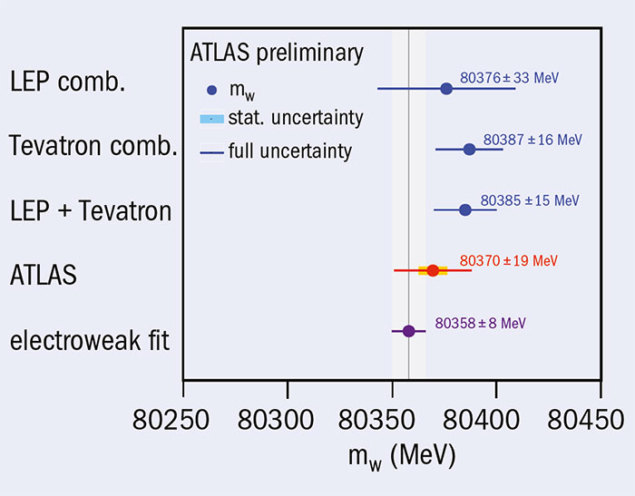
A precise measurement of the mass of the W boson, which was discovered at CERN in 1983, is vital because it is closely related to the masses of the top quark and the Higgs boson. Measuring the W mass tests this prediction and thus the self-consistency of the Standard Model (SM), since any deviation from theory would be a sign of new physics. The W mass was measured previously at CERN’s Large Electron–Positron (LEP) collider and Fermilab’s proton–antiproton collider, the Tevatron, yielding a world average of 80.385±0.015 GeV, which is consistent with the SM constraints of 80.358±0.008 GeV.
The ATLAS collaboration has now reported the first measurement of the W mass at the LHC, based on proton–proton collisions at a centre-of-mass energy of 7 TeV (corresponding to an integrated luminosity of 4.6 fb–1). The measured value, 80.370±0.019 GeV, matches the precision of the best single-experiment measurement of the W mass performed by the Tevatron’s CDF experiment, and is consistent with both the SM prediction and combined measurements (see figure).
Measuring the W mass is more challenging at the LHC compared with LEP and the Tevatron because there are a large number of interactions per beam crossing and significant contributions to W production from second-generation quarks (strange and charm). ATLAS measured the W mass by reconstructing the kinematic properties of leptonic decays, in which a W produces an electron or muon and a neutrino in the final state.
The analysis required a highly accurate calibration of the detector response, which was achieved via the large sample of Z-boson events and the precise knowledge of the Z mass. Accurate predictions of the W-boson production and decay properties are also crucial at a proton–proton collider. The enhanced amount of heavy-quark-initiated production and the ratio of valence and sea quarks in the proton affect the W boson’s transverse-momentum distribution and its polarisation, which makes the measurement sensitive to the parton distribution functions of the proton. To address these issues, ATLAS combined the most advanced theoretical predictions with experimental constraints from precise measurements of Z- and W-boson differential cross-sections and of Z-boson transverse momentum and polarisation.
Future analysis of larger data samples at the LHC would allow the reduction of the statistical uncertainty and of several experimental systematic uncertainties. Finally, a better knowledge of the parton distribution functions and improved QCD and electroweak predictions of W- and Z-boson production are crucial to further reduce the theoretical uncertainties.





